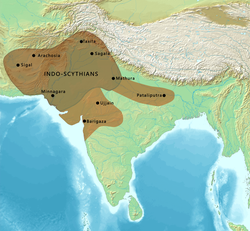
Back الهنود السكثيون Arabic Indoescites AST Һинд-скиф батшалығы Bashkir Индо-скитско царство Bulgarian Indo-Escita Catalan Indoskythové Czech Indo-Skythische Dynastie German Indoescitas Spanish Indo-eszitiarrak Basque پادشاهی هندوسکایی Persian
Indo-Scythian Kingdom | |||||||||||||||||||||
|---|---|---|---|---|---|---|---|---|---|---|---|---|---|---|---|---|---|---|---|---|---|
| c. 150 BCE–400 CE | |||||||||||||||||||||
 Territories and expansion of the Indo-Scythians at their greatest extent, including territories of the Northern Satraps and Western Satraps. | |||||||||||||||||||||
| Capital | |||||||||||||||||||||
| Common languages | Saka,[1] Greek, Pali (Kharoshthi script), Sanskrit, Prakrit (Brahmi script) | ||||||||||||||||||||
| Religion | Hinduism | ||||||||||||||||||||
| Government | Monarchy | ||||||||||||||||||||
| King | |||||||||||||||||||||
• 85–60 BCE | Maues | ||||||||||||||||||||
• 10 CE | Hajatria | ||||||||||||||||||||
| Historical era | Antiquity | ||||||||||||||||||||
• Established | c. 150 BCE | ||||||||||||||||||||
• Disestablished | 400 CE | ||||||||||||||||||||
| Area | |||||||||||||||||||||
| 20 est.[6] | 2,600,000 km2 (1,000,000 sq mi) | ||||||||||||||||||||
| |||||||||||||||||||||
| History of South Asia |
|---|
 |
The Indo-Scythians (also called Indo-Sakas) were a group of nomadic people of Iranic Scythian origin who migrated from Central Asia southward into the northwestern Indian subcontinent: the present-day South Asian regions of Afghanistan, Pakistan, Eastern Iran and northern India. The migrations persisted from the middle of the second century BCE to the fourth century CE.
The first Saka king of India was Maues/Moga (first century BCE) who established Saka power in Gandhara, the Indus Valley, and other regions. The Indo-Scythians extended their supremacy over the north-western subcontinent, conquering the Indo-Greeks and other local peoples. They were apparently subjugated by the Kushan Empire's Kujula Kadphises or Kanishka.[a] The Saka continued to govern as satrapies,[b] forming the Northern Satraps and Western Satraps. The power of the Saka rulers began to decline during the 2nd century CE after the Indo-Scythians were defeated by the Satavahana emperor Gautamiputra Satakarni.[9][10] Indo-Scythian rule in the northwestern subcontinent ended when the last Western Satrap, Rudrasimha III, was defeated by the Gupta emperor Chandragupta II in 395 CE.[11][12]
The invasion of the northern Indian subcontinent by Scythian tribes from Central Asia, often referred to as the Indo-Scythian invasion, played a significant role in the history of the subcontinent and nearby regions. The Indo-Scythian war was triggered by the nomadic flight of Central Asians from conflict with tribes such as the Xiongnu in the second century CE, which had lasting effects on Bactria, Kabul and the Indian subcontinent and Rome and Parthia in the west. Ancient Roman historians, including Arrian[13] and Claudius Ptolemy, have mentioned that the ancient Sakas ("Sakai") were nomadic people.[14] The first rulers of the Indo-Scythian kingdom were Maues (c. 85–60 BCE) and Vonones (c. 75–65 BCE).[15]
- ^ Diringer, David (1953) [1948]. The Alphabet: A Key to the History of Mankind (Second and revised ed.). London: Hutchinson's Scientific and Technical Publications. p. 350.
- ^ Seldeslachts (2007), p. 142.
- ^ Neelis (2010), p. 110.
- ^ Hirakawa (1993), p. 230.
- ^ Encyclopedia Iranica, Indo-Scythian Dynasty
- ^ Taagepera, Rein (1979). "Size and Duration of Empires: Growth-Decline Curves, 600 B.C. to 600 A.D". Social Science History. 3 (3/4): 115–138. doi:10.2307/1170959. JSTOR 1170959.
- ^ A Catalogue of the Indian Coins in the British Museum. Andhras etc. Rapson, p. ciii
- ^ Rapson, Coins of the British Museum, p. cv
- ^ World history from Early Times to AD 2000 by B. V. Rao, p. 97
- ^ A Brief History of India, by Alain Daniélou p. 136
- ^ India in a Globalised World by Sagarika Dutt, p. 24
- ^ Ancient India by Ramesh Chandra Majumdar, p. 234
- ^ "Arrian: Anabasis Alexandri: Book VIII (Indica); Section V". Ancient History Sourcebooks. Fordham University. Retrieved 21 January 2019.
- ^ Ptolemy vi, xiii (1932), p. 143.
- ^ Suchandra Ghosh (11 January 2016). "Indo-Scythian (Saka) Kingdom". In Nigel Dalziel, John M MacKenzie (ed.). The Encyclopedia of Empire. Oxford, UK: John Wiley & Sons, Ltd. pp. 1–2. doi:10.1002/9781118455074.wbeoe067. ISBN 978-1-118-45507-4. Retrieved 28 January 2023.
Cite error: There are <ref group=lower-alpha> tags or {{efn}} templates on this page, but the references will not show without a {{reflist|group=lower-alpha}} template or {{notelist}} template (see the help page).
© MMXXIII Rich X Search. We shall prevail. All rights reserved. Rich X Search